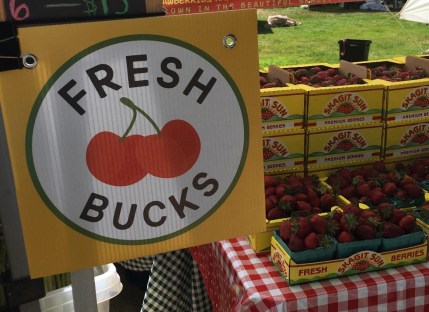A farmer’s market incentive program may increase access to fruits and vegetables for residents of low-income communities, suggests a study led by the University of Washington School of Public Health.
Researchers from the School worked with Public Health - Seattle & King County to evaluate three programs designed to increase fruit and vegetable consumption. All programs were beneficial but participants of one, called Fresh Bucks, appeared to eat significantly more produce.

Fresh Bucks participants use their benefits from the federal Supplemental Nutrition Assistance Program (SNAP) to make purchases at more than 35 farmer’s markets and market stands in Seattle and King County. SNAP funds spent at participating markets were matched at up to $10 with money that could be used to purchase fruits and vegetables. According to this study, 60 percent of people who used Fresh Bucks reported that they purchased half or more of their produce through the program.
“Fruit and vegetables are a critical piece of a healthy diet, but most people don’t eat enough for a number of reasons,” said senior co-author Emilee Quinn, research coordinator at the Center for Public Health Nutrition, housed in the UW School of Public Health.
“The Fresh Bucks program, which uses an incentive-based model that has become more and more commonly seen around the country, is the one for which we saw the strongest evidence that participants ate more fruits and vegetables as they used the program more often.”
Researchers also looked at subsidized farm stands and produce bag distribution. Mobile neighborhood farm stands sell wholesale or discounted produce to people at all income levels. The Good Food Bags program provides a weekly bag of produce sold at a discounted price (a $10 value sold for $5). Researchers interviewed 217 people who took part in one of the three programs.
“Through this evaluation, we saw that each of the three programs attracted somewhat different types of shoppers and that people using each program appreciated slightly different things about each – focusing to different degrees on how the program made produce more affordable, convenient or allowed them to support local farmers, for example,” Quinn said.
Of all the programs studied, Fresh Bucks participants reported the lowest income and highest food insecurity, mainly due to SNAP eligibility requirements. Fresh Bucks offers a larger amount and wider variety of produce options than farm stands or Good Food Bags. The Fresh Bucks program encouraged participants to purchase $20 worth of produce per visit and takes place at farmers markets with numerous vendors selling a range of produce types and varieties. Fresh Bucks participants also mentioned affordability as a key reason for accessing the program. This finding indicates that this program may uniquely address financial barriers for shoppers interested in purchasing healthier foods.
Though Fresh Bucks proved to be more effective, all programs showed signs of success.
“Together, these results help us understand the benefits of several approaches, and indicate there may be an advantage to offering multiple programs in a community to meet people’s various needs and concerns,” Quinn added.
